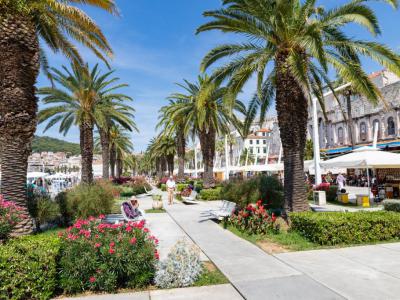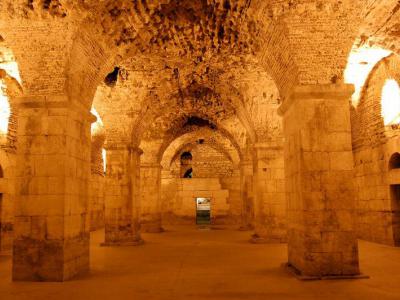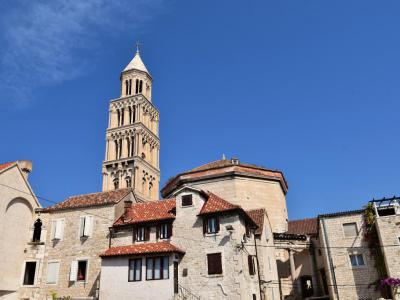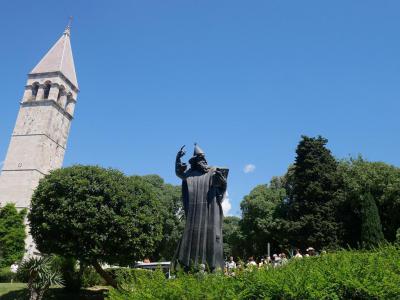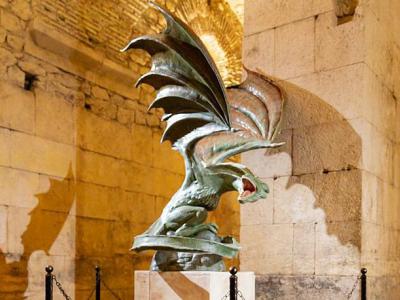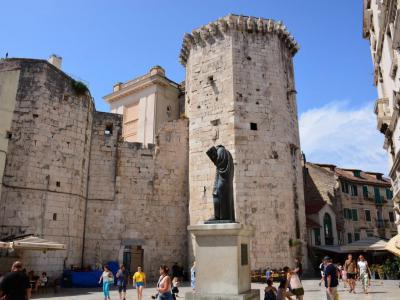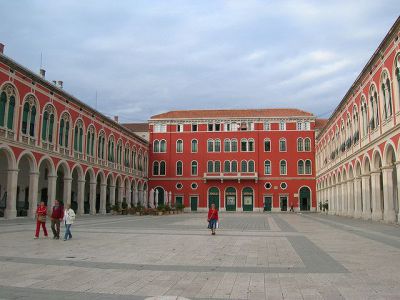
Split Introduction Walking Tour (Self Guided), Split
Split is the largest city in Dalmatia. It is a regional transport center, a tourist magnet, and the ancient dacha of the Roman emperor Diocletian. Like most other cities of the Mediterranean, it started out as a Greek colony. The original name was Aspalatos.
Supposedly, the city owes its name to the word for "spiny broom." Which spiny broom is not clear, but history has many such mysteries. It emerged as a prominent city in the year 650 when it supplanted neighboring Solana as the capital of Dalmatia.
Subsequently it has survived invasion by Slavs and Avars, Byzantium, Venice, Ottomans, Napoleon, Austria, Yugoslavia, Italy, Germany, Yugoslavia (Socialist) again, and at last, the Republic of Croatia.
The Emperor Diocletian unknowingly donated his fortress/palace to the nascent city. He retired from the exhausting duties of Emperor in the year 305. He arrived by ship at the water's edge entrance to his newly finished palace and settled down to raise cabbages.
In 1979 the center of Split was added to the UNESCO list of World Heritage Sites. The City is home to The Split Archeological Museum, the Split City Museum, the Ethnographical Museum, the Croatian Maritime Museum, and the Gallery of Fine Arts.
Start from the Riva Harbor. The sea once came up to the south wall but now one enters from the seaside promenade. The gate leads to the Podrum, the cellars of the palace. Within the bounds of Diocletian's dream retreat are now temples converted to churches and chapels.
Ancient streets and alleys are lined with Romanesque and Gothic buildings, peristyles, colonnades, and medieval squares. The Temple of Jupiter becomes a cathedral. Take this self-guided walking tour to explore the splendid city of Split.
Supposedly, the city owes its name to the word for "spiny broom." Which spiny broom is not clear, but history has many such mysteries. It emerged as a prominent city in the year 650 when it supplanted neighboring Solana as the capital of Dalmatia.
Subsequently it has survived invasion by Slavs and Avars, Byzantium, Venice, Ottomans, Napoleon, Austria, Yugoslavia, Italy, Germany, Yugoslavia (Socialist) again, and at last, the Republic of Croatia.
The Emperor Diocletian unknowingly donated his fortress/palace to the nascent city. He retired from the exhausting duties of Emperor in the year 305. He arrived by ship at the water's edge entrance to his newly finished palace and settled down to raise cabbages.
In 1979 the center of Split was added to the UNESCO list of World Heritage Sites. The City is home to The Split Archeological Museum, the Split City Museum, the Ethnographical Museum, the Croatian Maritime Museum, and the Gallery of Fine Arts.
Start from the Riva Harbor. The sea once came up to the south wall but now one enters from the seaside promenade. The gate leads to the Podrum, the cellars of the palace. Within the bounds of Diocletian's dream retreat are now temples converted to churches and chapels.
Ancient streets and alleys are lined with Romanesque and Gothic buildings, peristyles, colonnades, and medieval squares. The Temple of Jupiter becomes a cathedral. Take this self-guided walking tour to explore the splendid city of Split.
How it works: Download the app "GPSmyCity: Walks in 1K+ Cities" from Apple App Store or Google Play Store to your mobile phone or tablet. The app turns your mobile device into a personal tour guide and its built-in GPS navigation functions guide you from one tour stop to next. The app works offline, so no data plan is needed when traveling abroad.
Split Introduction Walking Tour Map
Guide Name: Split Introduction Walking Tour
Guide Location: Croatia » Split (See other walking tours in Split)
Guide Type: Self-guided Walking Tour (Sightseeing)
# of Attractions: 9
Tour Duration: 1 Hour(s)
Travel Distance: 1.2 Km or 0.7 Miles
Author: naomi
Sight(s) Featured in This Guide:
Guide Location: Croatia » Split (See other walking tours in Split)
Guide Type: Self-guided Walking Tour (Sightseeing)
# of Attractions: 9
Tour Duration: 1 Hour(s)
Travel Distance: 1.2 Km or 0.7 Miles
Author: naomi
Sight(s) Featured in This Guide:
- Riva Harbor
- Podrum (Cellars of Diocletian's Palace)
- Diocletian's Palace
- Cathedral of St. Domnius
- Grgur Ninski Statue
- Game of Thrones Museum
- People's Square (Pjaca)
- Fruit's Square
- Prokurative (Republic Square)
1) Riva Harbor (must see)
The promenade is an easy walk along the waterfront. Light breezes, sunshine, the clear deep blue the harbor. What a pleasure. Close your eyes. It could be juan-le-Pins, or even Monaco, porto Fino? No. It's Split.
Lots of benches here. One could sit and enjoy the view. It's a real break from shopping, tours, crowds. Need a snack? There are restaurants and cafes all along the way. The Emperor Diocletian got all his take out delivered directly from from ships at the south side of his great villa. Now one can get refreshments all along the waterfront.
Cruise ships dock at Split Riva Pier. They arrive every day to visit the exotic islands along the coast. Split is essentially a port city. A vital part of its existence is tied to the Adriatic Sea.
Still need a break? Pick a bench. Watch the sea change colors. Feed the pigeons. Wait for the sunset. You won't forget it.
Lots of benches here. One could sit and enjoy the view. It's a real break from shopping, tours, crowds. Need a snack? There are restaurants and cafes all along the way. The Emperor Diocletian got all his take out delivered directly from from ships at the south side of his great villa. Now one can get refreshments all along the waterfront.
Cruise ships dock at Split Riva Pier. They arrive every day to visit the exotic islands along the coast. Split is essentially a port city. A vital part of its existence is tied to the Adriatic Sea.
Still need a break? Pick a bench. Watch the sea change colors. Feed the pigeons. Wait for the sunset. You won't forget it.
2) Podrum (Cellars of Diocletian's Palace)
Under Diocletian's apartments were the cellars. Strong substructures which were used to support the apartments above and to store wine, foodstuffs and other items for the use of the Palace. The supports were a faithful copy of the structures above. The cellars also had a nymphaeum, a shrine dedicated to the nymphs guarding a source of fresh water.
In the middle ages the palace gradually became a safe haven for refugees. Part of the vast underground area was residential. In later times wealthier citizens who had houses above the Podrum would break through the vaults and turn them into storage spaces for themselves.
Today Diocletian's cellars can be reached through the Bronze Gate, or through a stair connected to the peristyle. The Western part of the Podrum is preserved. It is available to sightseers and is used as a fair and exhibition space. The collapsed Eastern part is being restored and will soon be accessible as well.
In the middle ages the palace gradually became a safe haven for refugees. Part of the vast underground area was residential. In later times wealthier citizens who had houses above the Podrum would break through the vaults and turn them into storage spaces for themselves.
Today Diocletian's cellars can be reached through the Bronze Gate, or through a stair connected to the peristyle. The Western part of the Podrum is preserved. It is available to sightseers and is used as a fair and exhibition space. The collapsed Eastern part is being restored and will soon be accessible as well.
3) Diocletian's Palace (must see)
The "Palace" of Diocletian is more than a palace. It is really a fortress. It provided not only a private retirement home for the ex-emperor, but quarters for an armed garrison. It was a "key" community like no other. The palace, built at the turn of the fourth century, today forms most of the old town of Split, Croatia.
The palace complex was built on a peninsula about 18 miles from Salona, then the capital of Dalmatia and the birthplace of the retired Roman emperor. When Diocletian died in 312, the palace complex remained a property of the Roman imperium. It was used as a residence and refuge for members of imperial family who were out of favor.
In the seventh century the country was invaded by Avars and Slavs and the city of Salona was destroyed. The people found security within the formidable walls of the palace. Safe behind the walls they formed a new city community. From that time the palace has been continually occupied and today it is the heart of the city of Split.
The mausoleum of Diocletian became the cathedral of Saint Domnius. In time the remains of the fortress home of the emperor dropped out of the consciousness of Europe. Then the Scottish architect Robert Adam surveyed the ruins and published his findings. The palace formed the inspiration for Adam's style of Neoclassical architecture.
The plan of the palace has been found to be an irregular rectangle with 16 towers from the facades and corners. Only the southern facade was unfortified. It provided easy access to the sea and vessels could unload cargo directly through the Sea Gate.
There are three other gates that grant entrance and egress. The North Gate guarded the road towards Salona. The Church of Saint Martin is above the gate. The East Gate faced the town of Epetia, now Stobrec.
The West Gate, was used as the military gate. It remains in use today. The South Gate faces the sea.
Why You Should Visit:
The long history and diverse cultures of Split are distilled and contained in this remarkable Palace.
Tips: Be prepared to do a lot of walking.
The palace complex was built on a peninsula about 18 miles from Salona, then the capital of Dalmatia and the birthplace of the retired Roman emperor. When Diocletian died in 312, the palace complex remained a property of the Roman imperium. It was used as a residence and refuge for members of imperial family who were out of favor.
In the seventh century the country was invaded by Avars and Slavs and the city of Salona was destroyed. The people found security within the formidable walls of the palace. Safe behind the walls they formed a new city community. From that time the palace has been continually occupied and today it is the heart of the city of Split.
The mausoleum of Diocletian became the cathedral of Saint Domnius. In time the remains of the fortress home of the emperor dropped out of the consciousness of Europe. Then the Scottish architect Robert Adam surveyed the ruins and published his findings. The palace formed the inspiration for Adam's style of Neoclassical architecture.
The plan of the palace has been found to be an irregular rectangle with 16 towers from the facades and corners. Only the southern facade was unfortified. It provided easy access to the sea and vessels could unload cargo directly through the Sea Gate.
There are three other gates that grant entrance and egress. The North Gate guarded the road towards Salona. The Church of Saint Martin is above the gate. The East Gate faced the town of Epetia, now Stobrec.
The West Gate, was used as the military gate. It remains in use today. The South Gate faces the sea.
Why You Should Visit:
The long history and diverse cultures of Split are distilled and contained in this remarkable Palace.
Tips: Be prepared to do a lot of walking.
4) Cathedral of St. Domnius (must see)
It was the year 305. Roman emperor Diocletian had persecuted a lot of Christians and like-minded dissidents in his Imperial tour of duty. Now it was time to retire to his native land of Dalmatia and raise vegetables. As the vegetables were growing, he built a mausoleum. His final resting place was in the center of Split. But he would not rest there forever.
By the seventh century the Cathedral of Saint Domnius was consecrated. The Cathedral was in fact the Mausoleum of Diocletian. Those darn Christians finally got him. The Cathedral is a cluster of ad-ons that have changed little over the years. The former Mausoleum is dedicated to the Virgin Mary. The bell tower, added in 1100, is dedicated to Saint Domnius.
Saint Domnius is the patron saint of Split. He was the Bishop of Salona, a Roman city and capital of Dalmatia. He was born in Antioch and he was beheaded, along with seven other Christians, in 304. Ironically, he died one year before Diocletian retired.
Diocletian was a soldier. Naturally his retirement home was a Roman army camp. There was an East-West road (decumanus) and a North-South road (cardo maximus). Those roads remain in Split today. At the intersection of the roads is a great peristyle which grants access from the east to the Cathedral of Saint Domnius.
The Cathedral evolved through three stages. Diocletian's Mausolem, the central part of the cathedral, dates from the end of the third century. It is composed of white marble, limestone, and brick. In the seventh century a choir was added to the mausoleum. Finally the bell tower was erected in 1100. There was further rebuilding in 1908.
Within the Church there are relics and art treasures. Found here is the 13th century panel Painting, Madonna and Child. There are reliquaries, chalices and vestments from the 13th to the 19th centuries. The library includes the Book of gospels (6th century), Kartularium from Sumpetar (11th century) and the Historia Salanitana (13th century).
Why You Should Visit:
To take in the ancient, medieval and modern Split all in one place.
By the seventh century the Cathedral of Saint Domnius was consecrated. The Cathedral was in fact the Mausoleum of Diocletian. Those darn Christians finally got him. The Cathedral is a cluster of ad-ons that have changed little over the years. The former Mausoleum is dedicated to the Virgin Mary. The bell tower, added in 1100, is dedicated to Saint Domnius.
Saint Domnius is the patron saint of Split. He was the Bishop of Salona, a Roman city and capital of Dalmatia. He was born in Antioch and he was beheaded, along with seven other Christians, in 304. Ironically, he died one year before Diocletian retired.
Diocletian was a soldier. Naturally his retirement home was a Roman army camp. There was an East-West road (decumanus) and a North-South road (cardo maximus). Those roads remain in Split today. At the intersection of the roads is a great peristyle which grants access from the east to the Cathedral of Saint Domnius.
The Cathedral evolved through three stages. Diocletian's Mausolem, the central part of the cathedral, dates from the end of the third century. It is composed of white marble, limestone, and brick. In the seventh century a choir was added to the mausoleum. Finally the bell tower was erected in 1100. There was further rebuilding in 1908.
Within the Church there are relics and art treasures. Found here is the 13th century panel Painting, Madonna and Child. There are reliquaries, chalices and vestments from the 13th to the 19th centuries. The library includes the Book of gospels (6th century), Kartularium from Sumpetar (11th century) and the Historia Salanitana (13th century).
Why You Should Visit:
To take in the ancient, medieval and modern Split all in one place.
5) Grgur Ninski Statue (must see)
May Gregory of Nin's Big Toe bring you good fortune. That's a nice thought. But you must go to Split and rub Gregory's big toe. Grigur Ninski (Gregory of Nin), was the Bishop of Nin in 926. Rome thought him a dangerous radical. He wanted to preach in the language of the people, since almost no one understood Latin, a condition that persists to this day.
Croatians consider Gregory as the defender of Croation language and culture. The City of Split has a huge statue of him (28 feet high). The statue was sculpted in 1929 by Ivan Mestrovic. The statue was in the center of Diocletian's Palace until 1941, when it was moved by Italian occupation forces. In 1954 it was moved to the City's Golden Gate.
Gregory is bronze and dark except for his big toe. It is worn smooth and golden by constant rubbings of tourists, travelers, pilgrims and local people. Croatians are said to believe that rubbing the toe will grant their wishes. Every day, for as long as Gregory has guarded the Golden Gate, the faithful have rubbed his toe.
Croatians consider Gregory as the defender of Croation language and culture. The City of Split has a huge statue of him (28 feet high). The statue was sculpted in 1929 by Ivan Mestrovic. The statue was in the center of Diocletian's Palace until 1941, when it was moved by Italian occupation forces. In 1954 it was moved to the City's Golden Gate.
Gregory is bronze and dark except for his big toe. It is worn smooth and golden by constant rubbings of tourists, travelers, pilgrims and local people. Croatians are said to believe that rubbing the toe will grant their wishes. Every day, for as long as Gregory has guarded the Golden Gate, the faithful have rubbed his toe.
6) Game of Thrones Museum (must see)
Split figured large in the filming of Game of Thrones (GOT). So it is only natural that Split should have an awesome Game of Thrones museum. The museum's address is 9 Bosanska Street. This is very close to the places where the series was actually filmed. Take Diocletian's Cellars, where a dragon's head once smashed through the ancient brick walls.
Luka Galik, the brain behind the Museum swears that everything is "just like" the series. "Split deserved the Game of Thrones Museum." He says. The museum has exhibits of photographs taken during the filming, and weapons and costumes that were worn. There are theme rooms of leading characters like, Khaleesi, Thyron, Hodor, Jack Sow, and others.
The Game of Thrones Museum has dark walls that help the grim atmosphere of the series. Aroma therapy is not neglected. The inside of the museum is filled with the aromas of cedar, Jasmine, lavender and ether oils. Smell a mystery, anyone? Yes, this is the place.
Luka Galik, the brain behind the Museum swears that everything is "just like" the series. "Split deserved the Game of Thrones Museum." He says. The museum has exhibits of photographs taken during the filming, and weapons and costumes that were worn. There are theme rooms of leading characters like, Khaleesi, Thyron, Hodor, Jack Sow, and others.
The Game of Thrones Museum has dark walls that help the grim atmosphere of the series. Aroma therapy is not neglected. The inside of the museum is filled with the aromas of cedar, Jasmine, lavender and ether oils. Smell a mystery, anyone? Yes, this is the place.
7) People's Square (Pjaca) (must see)
Like so many other squares in Split, People's Square is not the official name of the square. It was first called Saint Lawrence's Square in the 13th century. It has the distinction of being the first inhabited part of the City outside of Diocletian's Palace. For centuries the square has been the very center of City life.
The city clock has 24 numerals, not twelve. Life never pauses in the Square. One may rest, eat, drink, meet, see and be seen. The square is joined to the peristyle of old Diocletian's palace. As the city grew, the citizens started living outside the protection of the Roman walls and the square has been the People's Square ever since.
Renaissance, Venetian, and Gothic styles appear in the buildings around the square. The north side is occupied by the Old Town Hall, a 15th century building that sometimes hosts exhibitions of Art and history. It is said every building in Split has a story.
The attractions that might be seen in the square beside the Old Town Hall include: The ornate palaces of the nobility, the Church of Our Lady of the Bell Tower, The Old Town Clock. the Old Town Cafe, and the Morpurgo Bookstore (since 1860).
In the base of the flagpole of the Square one finds the words of the poet Tonci Petrasov:
"One doesn't need to travel anywhere,
nor does one have to search elsewhere,
what you are looking for is precisely here."
Here, in People's Square.
The city clock has 24 numerals, not twelve. Life never pauses in the Square. One may rest, eat, drink, meet, see and be seen. The square is joined to the peristyle of old Diocletian's palace. As the city grew, the citizens started living outside the protection of the Roman walls and the square has been the People's Square ever since.
Renaissance, Venetian, and Gothic styles appear in the buildings around the square. The north side is occupied by the Old Town Hall, a 15th century building that sometimes hosts exhibitions of Art and history. It is said every building in Split has a story.
The attractions that might be seen in the square beside the Old Town Hall include: The ornate palaces of the nobility, the Church of Our Lady of the Bell Tower, The Old Town Clock. the Old Town Cafe, and the Morpurgo Bookstore (since 1860).
In the base of the flagpole of the Square one finds the words of the poet Tonci Petrasov:
"One doesn't need to travel anywhere,
nor does one have to search elsewhere,
what you are looking for is precisely here."
Here, in People's Square.
8) Fruit's Square
Fruit's Square, one of the most popular tourist attractions in Split, is officially, Square Radic Brothers. Stjepan and Ante Radic were the founders of the Croatian Peasants Party in 1904. The party was actively opposed to the hegemony of Serbia in the local government. The brothers died in their cause but their efforts are remembered.
So why is it called Fruit's Square? It is popularly named Fruit's Square because this is where one would go to buy fruit; or to sell fruit. Today it is as aforesaid, a favorite tourist destination within the City. Its fame lies in its monuments, shops, pubs and clubs.
The most compelling structure of the Fruit's Square is the Venetian tower. The octagonal shaped building is a relic of the City's 15th century fortifications. Opposite the tower is a sumptuous Palace of the Milesi family from the 17th century. The Palace has a bold Baroque facade. It is probably the foremost example of Baroque style in Croatia.
In front of the Palace stands a statue of Marko Marulic, a 15th cenury philosopher called the father of Croatian literature. It is said that every stone in Fruit's Square, like the other old squares, are records of the history of the region. The elder times are preserved in the towers of Diocletian's Palace at the exit to the Square.
So why is it called Fruit's Square? It is popularly named Fruit's Square because this is where one would go to buy fruit; or to sell fruit. Today it is as aforesaid, a favorite tourist destination within the City. Its fame lies in its monuments, shops, pubs and clubs.
The most compelling structure of the Fruit's Square is the Venetian tower. The octagonal shaped building is a relic of the City's 15th century fortifications. Opposite the tower is a sumptuous Palace of the Milesi family from the 17th century. The Palace has a bold Baroque facade. It is probably the foremost example of Baroque style in Croatia.
In front of the Palace stands a statue of Marko Marulic, a 15th cenury philosopher called the father of Croatian literature. It is said that every stone in Fruit's Square, like the other old squares, are records of the history of the region. The elder times are preserved in the towers of Diocletian's Palace at the exit to the Square.
9) Prokurative (Republic Square)
Antonio Bajamonti, world famous Mayor of Split, Transformed the city from a simple coastal town to a cultural watering hole. He initiated the creation of Republic Square. An Italianate theatre, Teatro Bajamonti, opened in 1859. The theatre was paid for by His honor himself before he was His Honor.
Buildings line the square on three sides with the open side facing the sea. A Venetian style colonnade and neo Renaissance bas-reliefs below the windows were added. This is on the left side. On the right side there are no carvings or reliefs. The story is, the Venetian architect was so homesick he went back to Venice before the sides were finished.
The square has become a tourist magnet, especially in fine weather. It is also a popular venue for events, most notably the Split Music Festival.
Buildings line the square on three sides with the open side facing the sea. A Venetian style colonnade and neo Renaissance bas-reliefs below the windows were added. This is on the left side. On the right side there are no carvings or reliefs. The story is, the Venetian architect was so homesick he went back to Venice before the sides were finished.
The square has become a tourist magnet, especially in fine weather. It is also a popular venue for events, most notably the Split Music Festival.
Walking Tours in Split, Croatia
Create Your Own Walk in Split
Creating your own self-guided walk in Split is easy and fun. Choose the city attractions that you want to see and a walk route map will be created just for you. You can even set your hotel as the start point of the walk.
Diocletian Palace Tour
One of the best preserved monuments of the Roman architecture in the world, Diocletian's Palace was built for the Emperor Diocletian, at the turn of the 4th century AD, as his retirement home. Massive and resembling a fortress rather, it represents a combination of a luxury villa and a military garrison, and is divided into four parts by two main streets. Integral of the historic core of... view more
Tour Duration: 1 Hour(s)
Travel Distance: 0.6 Km or 0.4 Miles
Tour Duration: 1 Hour(s)
Travel Distance: 0.6 Km or 0.4 Miles
Marjan Hill Walking Tour
Marjan Hill is a picturesque natural wonder – a unique landform – located on the Split peninsula in Croatia. The majestic hill (or the low mountain, if you like) is surrounded by the sea and the city, and represents the green oasis ideal for walks, excursions, and rock climbing. Visitors to the area are greeted with a plethora of sights catering to various interests and equally enjoyed by... view more
Tour Duration: 1 Hour(s)
Travel Distance: 1.4 Km or 0.9 Miles
Tour Duration: 1 Hour(s)
Travel Distance: 1.4 Km or 0.9 Miles
The Most Popular Cities
/ view all
